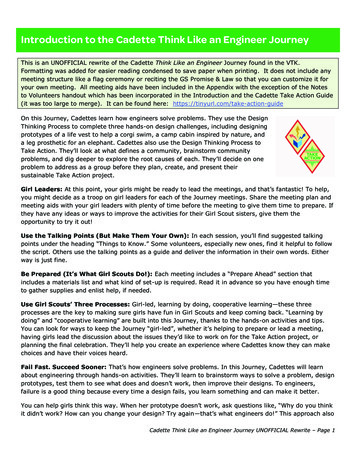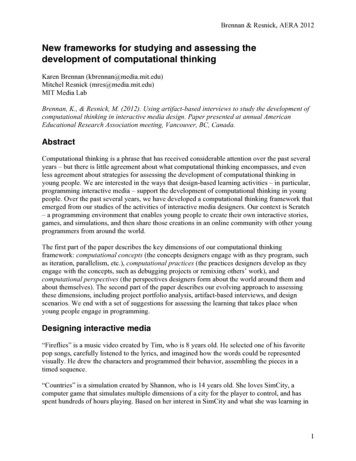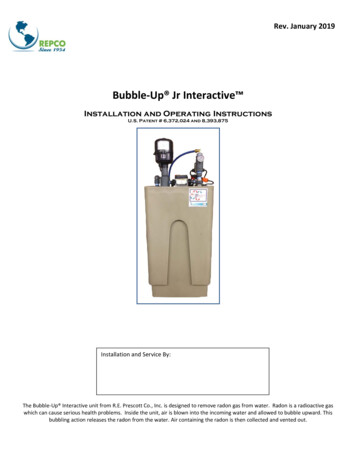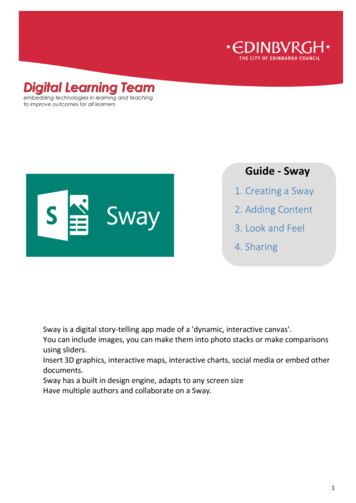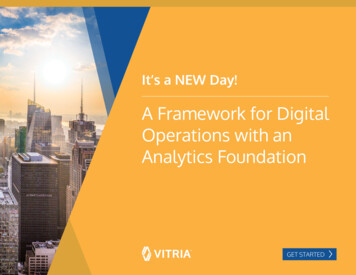
Transcription
It’s a NEW Day!A Framework for DigitalOperations with anAnalytics FoundationGET STARTED
It’s a NEW DAY! Companies thatwill thrive today and tomorrow aretransforming how they operate.An explosion of technology is enabling companies to rearchitecttheir operating models.Digital operations, operating models transformed by technology,.if you don’t reinventyourself and change yourorganization structure.you’re going to getis resulting in unprecedented efficiencies and savings.Transformative companies are taking a comprehensive view onhow to deploy people and technology to disrupt operationaldisrupted; and it will be amodels. There are many rewards like high speed innovation, abilitybrutal disruption where theto scale, cost avoidance and improved customer experience.majority of companies willnot exist in a meaningfulway 10 to 15 years out.JOHN THOMAS CHAMBERSFormer Executive Chairman andCEO of Cisco Systems2
SOME ORGANIZATIONSARE ALREADYAPPLYING SELECTEDTECHNOLOGIES TOIMPROVE OPERATIONS. Telecommunications and manufacturers are using technology to improve maintenanceprocesses and increase uptime. Financial services companies are managing risk by making better decisions in real time. Healthcare delivery organizations are launching population health initiatives providing morecare to more patients. Value chains are being replaced by value networks orchestrating interactions betweensuppliers, distributors, promoters and after sales services.Many organizations have already adopted new technologies like IoT, big data, AI and streaminganalytics. Others are implementing real time monitoring of operational health and performancein order to correlate measures with relevant business outcomes like sales, marketing and thecustomer experience.WHAT IS YOUR PLAN FOR DIGITAL OPERATIONS?3
THERE ARE MANYBUSINESS BENEFITS FORCOMPANIES TAKINGSTEPS TO DIGITIZE THEIROPERATIONS. Faster decision making Cost avoidance Speedy incident resolution across the business Predictable performance of systems and machineryDigital operations is foundational to companies that are serious about competing andwinning in their markets. The opportunities are real. Digital operations provides: New way to interact with customers Opportunity to create new, disruptive offerings Efficiency improvements falling to the bottom lineTO REALIZE THE BENEFITS, WHAT CHALLENGES STAND IN THE WAY?4
MANAGEMENT CONSULTANTS CAUTION ACHIEVINGDIGITAL OPERATIONS REQUIRES A COMPANY TOHAVE AN HOLISTIC AND INTEGRATED PLAN.Making disconnected decisions and taking isolated actions for short term gains can be a distraction.For example, placing sensors on equipment without a plan to analyze the data in real time, limits theimpact and benefits.The opportunity is immense, but the challenges are thought provoking and include: Shortage of functional and technical talent for related projects Aging technology infrastructure unable to support fast data ingest required for AI and analytics Inability to introduce new technologies into existing processes – and make them work Lack of leadership or inability to communicate the prioritiesIt’s important to start the journey and equally important to be prepared to meet the challenges head on.It’s a NEW DAY – your day to make incremental changes to staffing, technology and processes.Digital operations isn’t a destination – it’s a journey.ARE YOU READY FOR DIGITAL OPERATIONS?5
THE DIGITAL OPERATIONSFRAMEWORK AND THEANALYTICS FOUNDATIONVitria has worked with companies on this transformational journey. To help companies achieve the goal ofdigitizing operations, with high value wins along the way, we suggest this framework for digital operations andthe adoption of an analytics foundation.Let’s take a detailed look at the Digital Operations Framework!Digital operations is best achieved in stages, the stages building on one another. Taking a sequential approachensures the readiness of people and process and mitigates risk associated with significant transformations.Understanding the framework as a guide helps organization accelerate the journey. Working with Vitira, youcan assess your maturity against the framework, re-sequence your journey for positive results and enable thestages with one world class analytics solution.Stages of the Digital Operations Framework01 Real-TimeOperationalVisibility02 AdvancedAnomalyDetection03 DynamicPopulation04 IncidentLife-CycleAutomation05 DynamicFailurePredictionHOW WILL DIGITAL OPERATIONS CHANGE THE WAY WE WORK?6
01REAL TIME VISIBILITYData, data everywhere --coming from sensors and log files – more valuable when curated andintegrated in a meaningful way.Achieving real time visibility enables a necessary baseline. At this stage you can:Identify the variablesDetermine how to linkEstablish operationalthat you want to be ablethe metrics to businesshealth metrics orto controlperformance indicators likeperformance levelscustomer satisfactionBy providing visibility to meaningful information, engineers and managers and executives make betterdecisions in a timeframe that will make a difference for business outcomes.7
02ADVANCED ANOMALY DETECTIONThis stage is dependent on real-time visibility. Operations need to monitor performance of a growingnumber of assets. As companies implement new technology, operations is on a constant learningcurve. By using automated anomaly detection, you begin to close the learning gap and at the sametime identify complex and nuanced problems. Leveraging AI and machine learning algorithms,anomalies are detected faster with greater accuracy.Combining real time visibility to the data with advanced anomaly detection, organizations eliminatemeaningless alarms and false positives.EXAMPLETHE WINA NEW DAY for heavy machinery manufacturers who areReduced time to repair andreplacing capex driven maintenance contracts with a serviceincreased asset up time.based model. Combining real time visibility with advancedanomaly detection, manufacturers are applying algorithmson historic data to identify root-cause of anomalies andmute redundant alarms.8
03DYNAMIC POPULATIONSOne advantage of digitizing operations is having more control over change management activities.Once you get to stage 3 you have the ability from stages 1 and 2 to focus on meaningful anomalies andquickly identify root-cause. In stage 3 you achieve a better understanding of anomalies introduced byintentional change.At this stage detection of intentional changes is automated. This gives operations visibility to relatedanomalies, providing more control over change management. With this information they can act faster.EXAMPLETHE WINCommunications Service Providers [CSPs] find it difficult toCPSs proactively notify affecteddetect OS updates to smart phones in a large subscriberpopulations, efficiently pushbase. Using dynamic populations, CSPs can identify clusterscorrective updates and avoidof subscribers who have applied the OS change andinquiries and reduce complaintscorrelate the change population with reported anomalies– overall improving thelike ‘dropped calls’.customer experience.85%85% of incidents can be traced backto some sort of change activities.– Gartner9
04INCIDENT LIFECYCLE AUTOMATIONTransforming organizations are continuously adding large numbers of new devices which generate vastamounts of data. When operations is inundated with data of varying significance, it diminishes theireffectiveness at solving core issues. Operations needs to quickly make meaningful connections betweenvarious signals, then prioritize them to take necessary actions.Incident lifecycle automation provides event to event correlation and applies machine learningtechniques to aggregate in real time related anomalies. The key here is real time.In stages 1 through 3 operations is accumulating historic data which is then applied to new real time data. This resultsin only meaningful incidents based on historically acquired knowledge.Incident lifecycle automation identifies incidents in real time and triggers automated actions. Managingincidents in this way deflects support calls, even automatically rebooting some service delivery components.EXAMPLETHE WINThe entire lifecycle for incidents can be managed byPrecise incident identificationupdating severity and prioritizing incident resolution basedand lifecycle automationon actual and predicted business impacts. Incident lifecycleresults in sustainable uptime,automaton improves collaboration between operations teamlower costs and greater usermembers who may be assigned different responsibilitiessatisfaction scores.across the incident lifecycle.10
05DYNAMIC FAILURE PREDICTIONBecause the cost of production and service delivery outage can be high, operations and manufacturers ofequipment have relied on periodic maintenance, controlled tests and field experience to avoid outages.What if you could replace the precautions with the proactive ability to predict failures?This stage combines all the power of stages 1 through 4 enabling potential problems to be solved beforethey impact the business and the customer downstream. This stage is the future for most organizations.It has the greatest potential but is the most difficult to achieve because of the knowledge required and thespecialized nature of the technologies themselves.Today, it is possible, with the extensive use of sensors and internet of things (IoT), to collect predictorsof a failure state. Then employing artificial intelligence (AI), to provide the ability to interpret the signals,extract patterns and trigger pro-active resolution.EXAMPLETHE WINManufacturers using robots on an assembly line collectAvoiding downtime contains thesensor data for vibration and rotation and create signaturesmanufacturing costs and morethat predict the likelihood of failure for a given robot. Theimportant enables a businessrobots are monitored for the occurrence of the signaturesto ensure on time delivery ofand imminent failures are predicted. Proactive maintenancegoods to fill orders, keep shippingis scheduled.schedules on track and exceed thebuyers’ expectations for reliable,on time delivery.WHAT IS THE ROLE OF ANALYTICS IN ACTUALIZINGTHE DIGITAL OPERATIONS FRAMEWORK?11
MAKING THETECHNOLOGY WORKFOR YOU!As you’ve seen, at every stage of the journey, companies adopt new technologies like AI, IoT, big datainfrastructures and machine learning. All these projects require an analytics foundation for thesetechnologies to deliver the WIN!There are many analytics point products. Organizations often fall into the trap of selecting a differentproduct at various stages of the journey. When selecting the analytics foundation consider What is required to get a solution up and running? What is required for a successful stage1 implementation? What is required to operate solutions across the entire 5 stages of the digital operations frameworkWHAT IS THE VITRIA VALUE AS AN ANALYTICS FOUNDATION?12
VIA BY VITRIAVIA by Vitria, a comprehensive analytics foundation, adding value during implementation andongoing enablement of all stages of the digital operations framework.To achieve tangible results quickly, you want an analytics foundation that can be customizedbut without months of effort and costly consulting. One hallmark of VIA is the large library ofconfigurable routines that can be assembled in a low code, visual environment.What are the VIA differentiators during set up? VIA reduces reliance on highly skilled resources: availability of experts is problematic.VIA abstracts the complexity; this means operations personnel can use it with minimal training. VIA is complete: By this we mean that VIA is able to handle end to end processes from datacollection to automated problem resolution. VIA is not limited by number of sites, users, the systems it supports or the quantity of data stored.It is designed to SCALE. VIA is OPEN. This means it connects to third party systems, even legacy systems, to simplify datacollection and any relevant operations systems already deployed.WHAT IS THE VALUE OF USING ONE ANALYTICS FOUNDATIONACROSS THE DIGITAL OPERATIONS FRAMEWORK?VIA13
THE SINGLE MOST IMPORTANT REASON FORCHOOSING VIA BY VITRIA IS THAT IT ISEXTENSIBLE – SUPPORTING NEW USE CASESTHROUGHOUT YOUR JOURNEY.Businesses aren’t static, they evolve and so do their journeys to digital operations.VIA by Vitria is self-learning and adapts to changing conditions. Advantages include: Models that underpin AI algorithms update themselves with minimal human intervention.This saves time but more important triggers greater agility and reduces dependence onspecialized resources like data scientists. VIA has been shown to improve performance in days not weeks or months. Quick wins engageparticipants and contribute to financial results. Iterative wins minimize the risks associated withactualizing digital operations.ARE YOU READY FOR VIA BY VITRIA?14
VITRIA ARE YOU READYFOR A NEW DAY?READY TO CHANGE THE WAY YOU WORK?ARE YOU READY FOR VIA BY VITRIA?Call today for a freeWatch how VIA agile analyticsconsultation.makes everyone an analyst!CONTACT USCONTACT US
As you’ve seen, at every stage of the journey, companies adopt new technologies like AI, IoT, big data infrastructures and machine learning. All these projects require an analytics foundation for these technologies to deliver the WIN! There are many analytics point products. Organi


